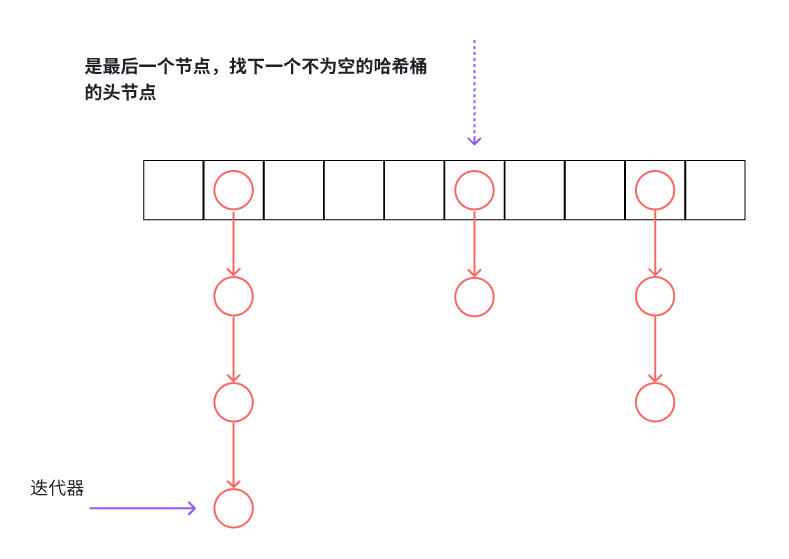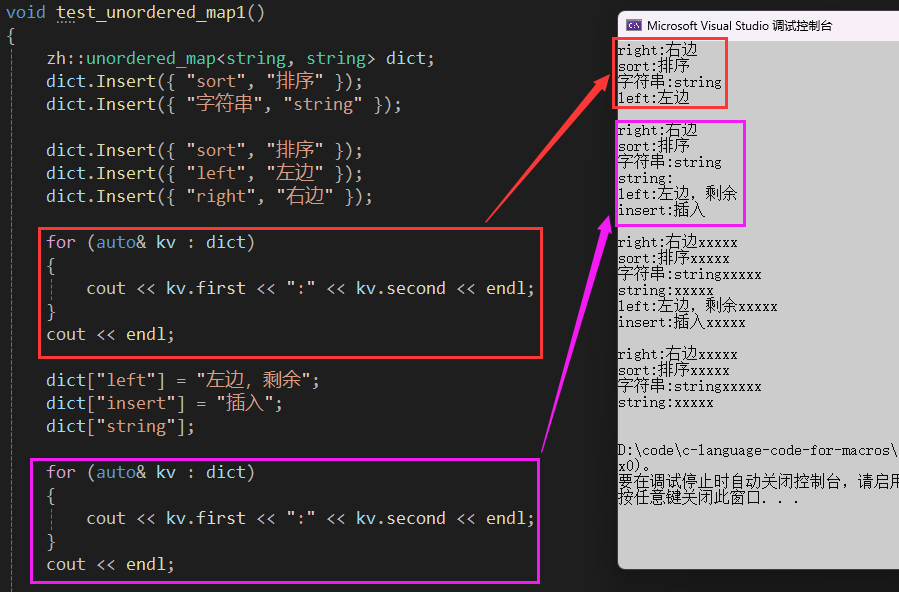文章目录
修改哈希表模板参数迭代器``HashTable`` 的默认成员函数``HashTable`` 迭代器相关函数``HashTable`` 的 ``Insert`` 函数``HashTable`` 的 ``Find``函数``HashTable`` 的 ``Erase``函数 封装 unordered_set封装 unordered_map测试 unordered_set 和 unordered_map
修改哈希表
我们基于链地址法实现的哈希表来封装实现 unordered_set 和 unordered_map ,但是由于实现的哈希表是 Key-Value 结构的并且我们的实现的哈希表缺少了迭代器,所以我们需要对之前实现的哈希表进行改造。
模板参数
HashNode
节点里不再存储确定的 pair<K, V> ,而是类型 T ,代表代表存储的数据可能是 key 或者 key-Value 。
template<class T>struct HashNode{T _data;HashNode<T>* _next;HashNode(const T& data):_data(data), _next(nullptr){}};HashTable
template<class K, class T, class KeyOfT, class hash = HashFunc<K>>class HashTableK :代表的是 keyT :代表是存的可能是 key 或者 key-valueKeyOfT :仿函数,目的是拿到 T 里面的 key 迭代器
哈希表的迭代器其实就是对节点指针进行封装,而且是单向迭代器,只需实现 ++ 即可。
//哈希表与迭代器相互依赖,需要前置声明template<class K, class T, class KeyOfT, class hash>class HashTable;template<class K, class T, class KeyOfT, class Hash, class Ref, class Ptr>struct HTIterator{typedef HashNode<T> Node;typedef HashTable<K, T, KeyOfT, Hash> HT;typedef HTIterator<K, T, KeyOfT, Hash, Ref, Ptr> Self;Node* _node;//需要用到哈希表里的数组大小,故需要指向哈希表的指针const HT* _pht;HTIterator(Node* node, const HT* pht):_node(node),_pht(pht){}Ref operator*(){return _node->_data;}Ptr operator->(){return &_node->_data;}bool operator!=(const Self& s){return _node != s._node;}Self& operator++(){//...} };由于哈希表的特殊性,其迭代器的 ++ 较为复杂,也是实现哈希表迭代器的重点。
重载 ++
迭代器的++分为两种情况:


Self& operator++(){//当前哈希桶还有数据,直接到下一个节点if (_node->_next){_node = _node->_next;}//当前哈希桶走完了,寻找下一个不为空的哈希桶else if (_node->_next == nullptr){KeyOfT kot;Hash hashfunc;size_t hashi = hashfunc(kot(_node->_data)) % _pht->_tables.size();++hashi;while (hashi < _pht->_tables.size()){_node = _pht->_tables[hashi];//找到了下一个桶if (_node)break;else++hashi;}//处理迭代器在最后一个不为空的哈希桶的最后一个节点的情况if (hashi == _pht->_tables.size()){_node = nullptr;}}return *this;}Self& operator++(int){Self tmp = *this;++(*this);return tmp;}HashTable 的默认成员函数
//构造函数HashTable(): _tables(__stl_next_prime(0)), _n(0){}//拷贝构造函数HashTable(const HashTable<K, T, KeyOfT, hash>& ht){_tables.resize(ht._tables.size());for (auto& data : ht){Insert(data);}}//赋值重载HashTable<K, T, KeyOfT, hash>& operator=(const HashTable<K, T, KeyOfT, hash>& ht){vector<Node*> newtables(ht._tables.size());for (size_t i = 0; i < ht._tables.size(); ++i){Node* cur = ht._tables[i];while (cur){Node* newnode = new Node(cur->_data);newnode->_next = newtables[i];newtables[i] = newnode;cur = cur->_next;}}_tables.swap(newtables);return *this;}//析构函数~HashTable(){for (size_t i = 0; i < _tables.size(); ++i){Node* cur = _tables[i];while (cur){Node* next = cur->_next;delete cur;cur = next;}_tables[i] = nullptr;}}HashTable 迭代器相关函数
typedef HTIterator<K, T, KeyOfT, hash, T&, T*> Iterator;typedef HTIterator<K, T, KeyOfT, hash, const T&, const T*> Const_Iterator;Iterator begin(){if (_n == 0)return end();for (size_t i = 0; i < _tables.size(); ++i){Node* cur = _tables[i];if (cur){return Iterator(cur, this);}}return end();}Iterator end(){return Iterator(nullptr, this);}Const_Iterator begin() const{if (_n == 0)return end();for (size_t i = 0; i < _tables.size(); ++i){Node* cur = _tables[i];if (cur){return Const_Iterator(cur, this);}}}Const_Iterator end() const{return Const_Iterator(nullptr, this);}begin() 对应的迭代器应该是哈希表中第一个非空的哈希桶的头节点,需要特别处理。
end() 直接返回空指针对应的迭代器即可。
HashTable 的 Insert 函数
对于 Insert 函数,只需将其返回值改成迭代器与布尔值的 pair ,再将原本关于使用到 key 的地方套一层 KeyOfT 实例化出来的对象即可。
void CheckCapacity(){if (_n == _tables.size()){//把哈od希桶里的链表每个节点拆下来插入newht效率太低了/*HashTable<K, V> newht;newht._tables.resize(__stl_next_prime(_tables.size() + 1));for (size_t i = 0; i < _tables.size(); ++i){Node* cur = _tables[i];while (cur){newht.Insert(cur->_kv);cur = cur->_next;}}_tables.swap(newht._tables);*/KeyOfT kot;hash hashfunc;vector<Node*> newtables(__stl_next_prime(_tables.size() + 1));for (size_t i = 0; i < _tables.size(); ++i){Node* cur = _tables[i];while (cur){Node* next = cur->_next;size_t hashi = hashfunc(kot(cur->_data)) % newtables.size();//头插cur->_next = newtables[hashi];newtables[hashi] = cur;cur = next;}_tables[i] = nullptr;}_tables.swap(newtables);}}pair<Iterator, bool> Insert(const T& data){KeyOfT kot;Iterator it = Find(kot(data));//不等于end()说明哈希表里有重复元素if (it != end())return { it, false };//检查是否需要扩容CheckCapacity();hash hashfunc;size_t hashi = hashfunc(kot(data)) % _tables.size();Node* newnode = new Node(data);newnode->_next = _tables[hashi];_tables[hashi] = newnode;++_n;return { Iterator(newnode, this), false };}HashTable 的 Find函数
将返回值改为迭代器,原本用到 key 的地方套一层 KeyOfT 实例化出来的对象即可。
Iterator Find(const K& key){KeyOfT kot;hash hashfunc;size_t hashi = hashfunc(key) % _tables.size();Node* cur = _tables[hashi];while (cur){if (kot(cur->_data) == key){return Iterator(cur, this);}cur = cur->_next;}//没找到就返回return end();}HashTable 的 Erase函数
跟 Insert 函数的处理基本一样,不多叙述了。
bool Erase(const K& key){KeyOfT kot;hash hashfunc;size_t hashi = hashfunc(key) % _tables.size();Node* prev = nullptr;Node* cur = _tables[hashi];while (cur){if (kot(cur->_data) == key){//删除头节点的情况if (prev == nullptr){_tables[hashi] = cur->_next;}//非头节点的情况else{prev->_next = cur->_next;}delete cur;--_n;return true;}else {prev = cur;cur = cur->_next;}}return false;}封装 unordered_set
对 HashTable 的迭代器和函数进行封装即可,灰常简单。
template<class K, class hash = HashFunc<K>>class unordered_set{struct SetKeyOfT{const K& operator()(const K& key){return key;}};public:typedef typename hash_bucket::HashTable<K, const K, SetKeyOfT, hash>::Iterator iterator;typedef typename hash_bucket::HashTable<K, const K, SetKeyOfT, hash>::Const_Iterator const_iterator;iterator begin(){return _ht.begin();}iterator end(){return _ht.end();}const_iterator begin() const{return _ht.begin();}const_iterator end() const{return _ht.end();}pair<iterator, bool> Insert(const K& key){return _ht.Insert(key);}iterator Find(const K& key){return _ht.Find(key);}bool Erase(const K& key){return _ht.Erase(key);}private:hash_bucket::HashTable<K, const K, SetKeyOfT, hash> _ht;};封装 unordered_map
也是对 HashTable 的迭代器和函数进行封装,但有所不同的是,还需要多重载 [] ,也比较简单。
template<class K, class V, class hash = HashFunc<K>>class unordered_map{struct MapKeyOfT{const K& operator()(const pair<K, V>& kv){return kv.first;}};public:typedef typename hash_bucket::HashTable<K, pair<const K, V>, MapKeyOfT, hash>::Iterator iterator;typedef typename hash_bucket::HashTable<K, pair<const K, V>, MapKeyOfT, hash>::Const_Iterator const_iterator;iterator begin(){return _ht.begin();}iterator end(){return _ht.end();}const_iterator begin() const{return _ht.begin();}const_iterator end() const{return _ht.end();}pair<iterator, bool> Insert(const pair<K, V>& kv){return _ht.Insert(kv);}V& operator[](const K& key){pair<iterator, bool> ret = Insert({ key, V() });return ret.first->second;}iterator Find(const K& key){return _ht.Find(key);}bool Erase(const K& key){return _ht.Erase(key);}private:hash_bucket::HashTable<K, pair<const K, V>, MapKeyOfT, hash> _ht;};测试 unordered_set 和 unordered_map



拜拜,下期再见?
摸鱼ing?✨?

我的博客即将同步至腾讯云开发者社区,邀请大家一同入驻:https://cloud.tencent.com/developer/support-plan?invite_code=3kzw99ffumyoo